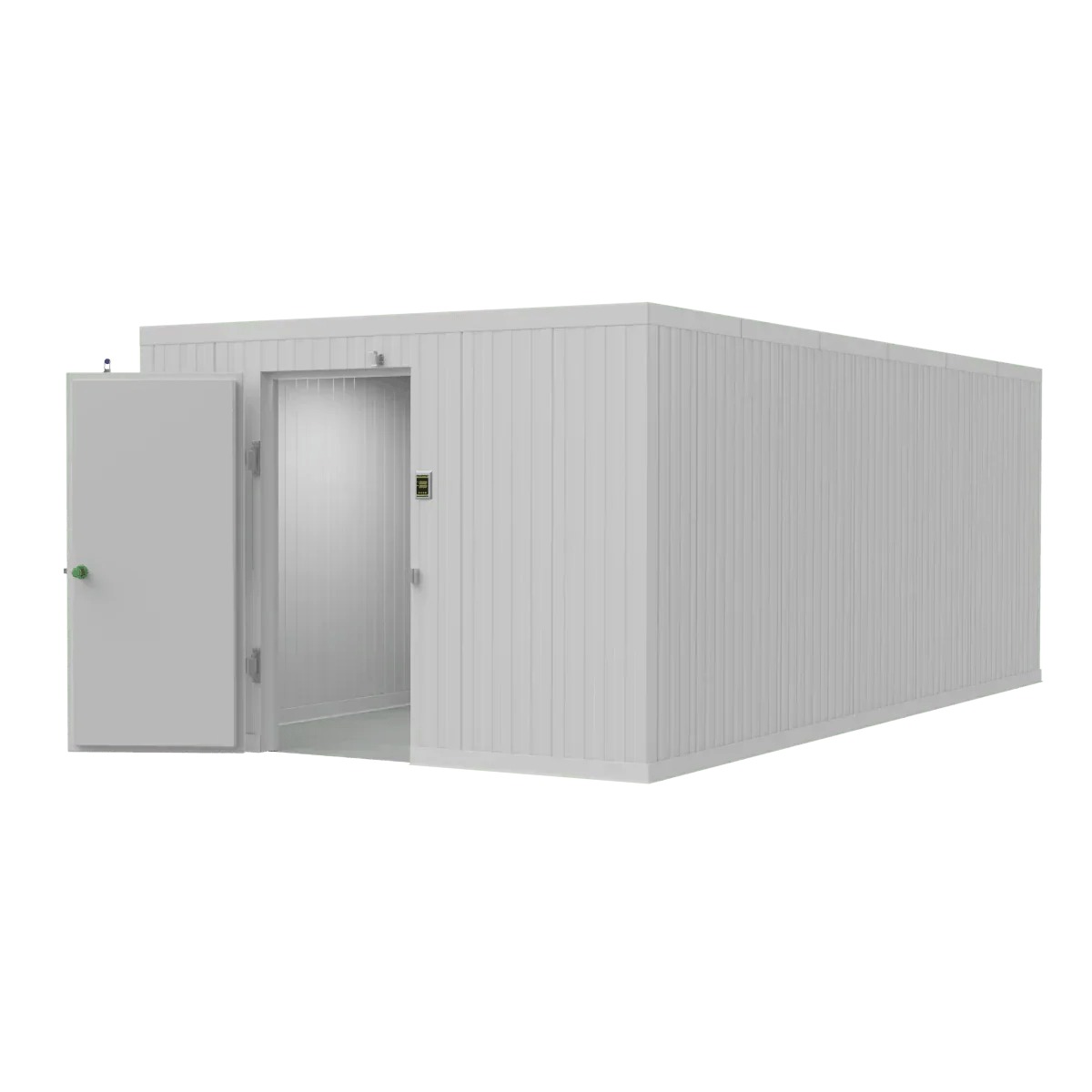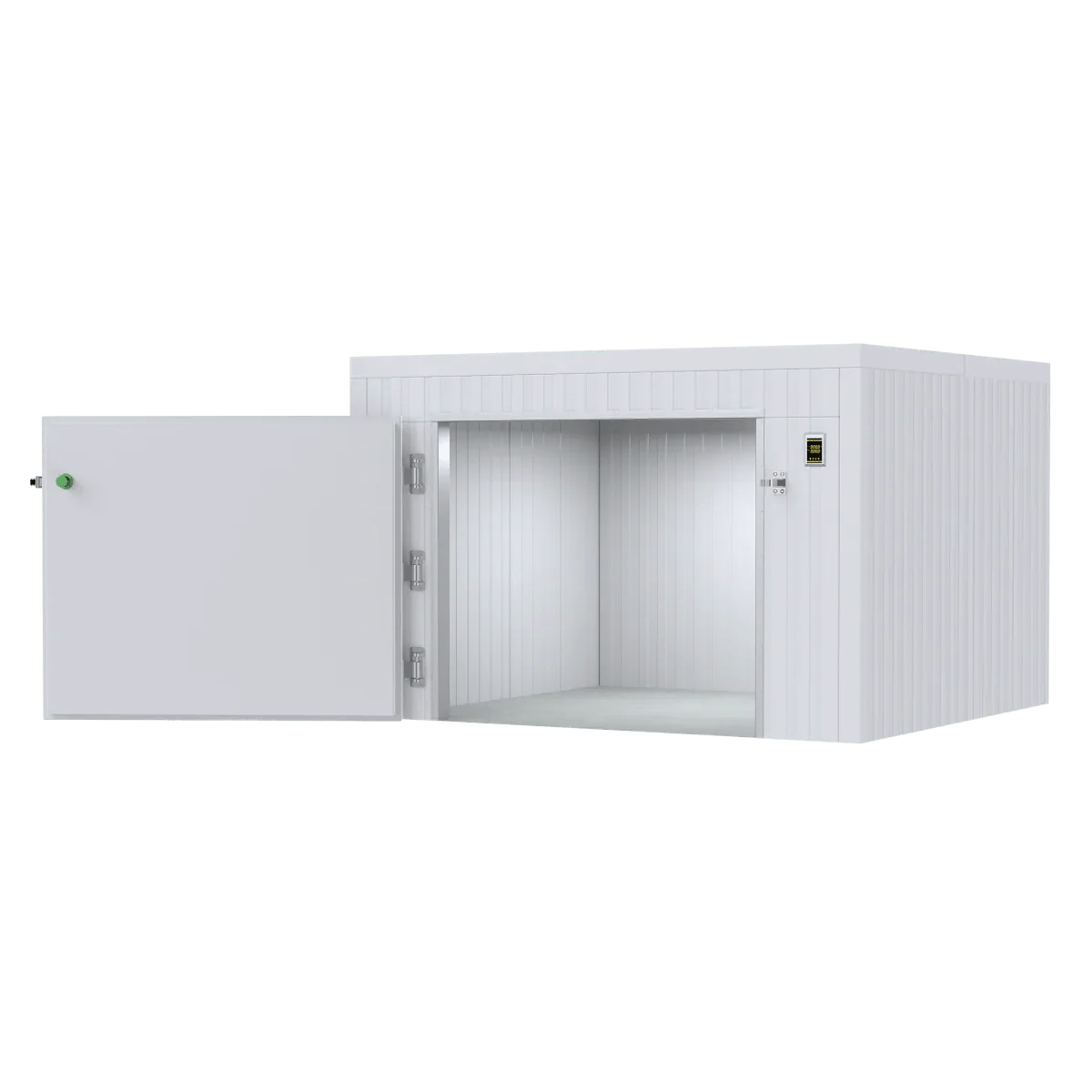Why Autopsy Tables Are Essential for Safe and Efficient Post-Mortem Examinations
An autopsy-table- is a specialized stainless steel work surface designed for post-mortem examinations, body preparation, and forensic investigations. These tables feature integrated drainage systems, adjustable heights, and ventilation to ensure examiner safety and workflow efficiency.
Key Features of Modern Autopsy Tables:
- Materials: 304 or 316 grade stainless steel construction
- Dimensions: Standard 99.75" L × 30.25" W × 35.5" H
- Height Range: Adjustable 820mm to 1020mm (32.3" to 40.2")
- Drainage: Integrated sinks (14" × 20" × 10") with sloped surfaces
- Ventilation: Downdraft extraction systems for odor and pathogen control
- Safety: GFCI outlets, rounded edges, non-slip surfaces
Modern autopsy tables serve forensic laboratories, medical schools, mortuaries, and veterinary facilities. They support critical procedures from cause-of-death investigations to medical education, where precision and hygiene are non-negotiable.
The choice of autopsy table directly impacts examination quality, workflow efficiency, and examiner safety. As American Mortuary Coolers, we've helped funeral homes and medical facilities select the right autopsy-table- solutions for their unique workflows and space requirements.

Easy autopsy-table- glossary:
What Is an Autopsy Table and Why Does It Matter?
An autopsy-table- serves as the command center for post-mortem examinations. It's where pathologists, medical examiners, and forensic specialists gather evidence needed to understand what happened to someone who has died. Whether determining cause of death in forensic investigations or teaching medical students about human anatomy, these specialized tables make it all possible.
An autopsy table isn't just a work surface - it's sophisticated equipment that handles biological fluids safely, controls dangerous airborne particles, and creates ergonomic workspaces. Post-mortem workflow depends entirely on having the right setup, where every detail matters for forensic pathology and medical education.
Anatomy of the Process
Body positioning is crucial during any autopsy, and smart table design makes this possible. The surface has a subtle slope that guides fluids naturally toward the drainage system, preventing pooling and maintaining a clean workspace throughout procedures.
Fluid control happens automatically with well-designed autopsy-table- systems. Integrated drainage systems with sloped surfaces work with gravity to keep everything flowing properly, while the stainless steel construction won't absorb biological materials, ensuring trace evidence stays available for collection and analysis.
Adjustable height features allow examiners to position tables at exactly the right level, accessing different body areas without straining or compromising their view. Some tables include optional body supports that help maintain proper positioning throughout longer procedures.
Core Components & Materials of Modern Autopsy-Table- Designs
When investing in an autopsy-table-, materials and construction quality determine whether equipment lasts decades or becomes costly problems. The backbone of quality autopsy tables is stainless steel construction, specifically grades 304 or 316. We recommend 316 grade stainless steel for superior corrosion resistance against daily exposure to biological fluids, cleaning chemicals, and disinfectants.
Stainless steel advantages include non-porous surfaces that create hostile environments for bacteria, making thorough disinfection effective. Heliarc-welded seams and joints create seamless transitions that eliminate contamination hiding spots, while large inside and outside radii make cleaning straightforward.
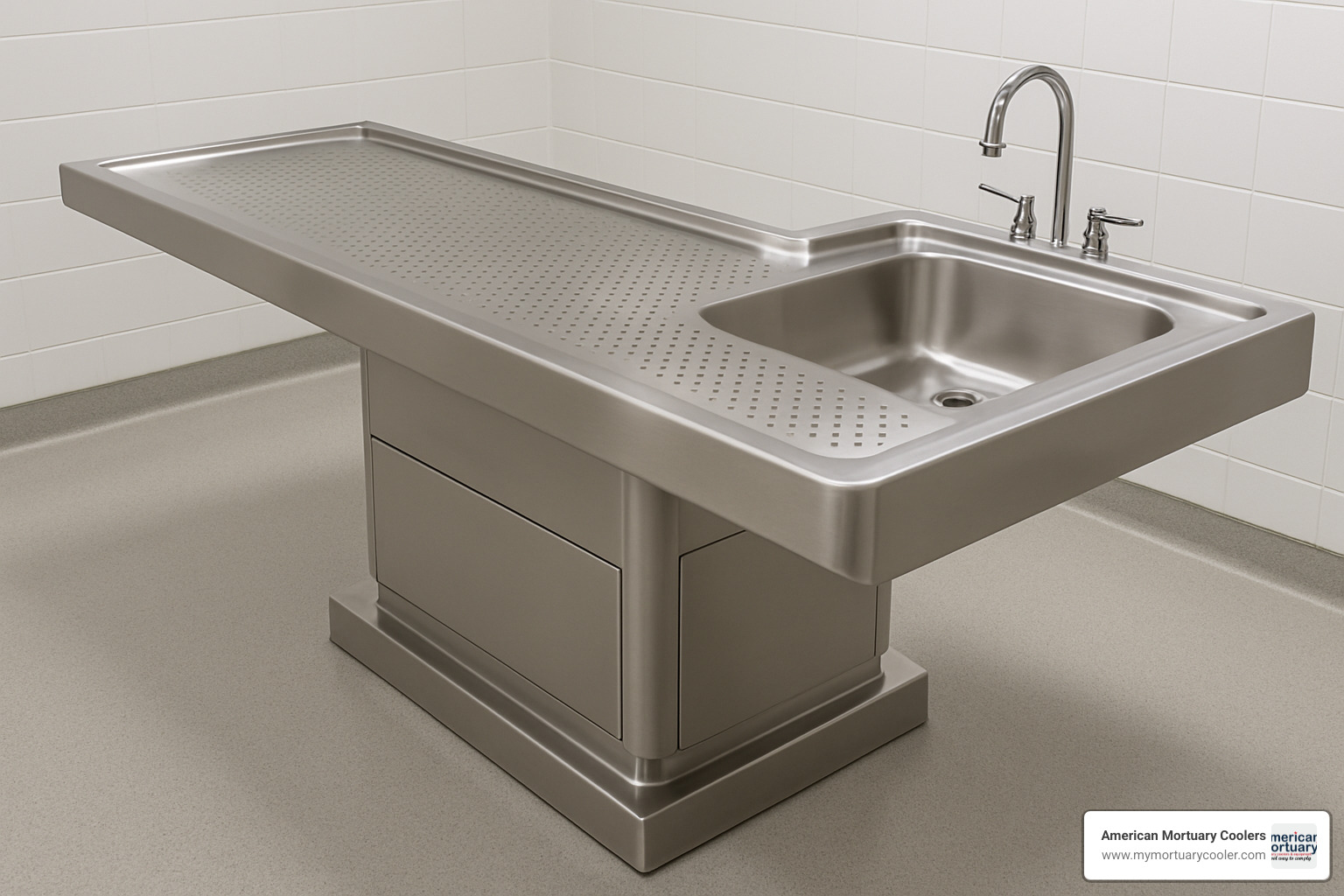
Drainage & Ventilation Systems
Drainage systems represent the heart of functional autopsy-table- design. Sloped surfaces direct fluids toward integrated sinks (typically 14 inches by 20 inches by 10 inches), while sump irrigation systems prevent debris buildup and staining.
Downdraft extraction systems have revolutionized autopsy table safety. The Ventilated Autopsy Table features peripheral extraction around the table perimeter that captures airborne contaminants at their source, creating negative pressure zones that pull aerosols and odors away from examiners.
Ergonomics & Safety
Adjustable height mechanisms between 820mm and 1020mm prevent long-term injury and fatigue. Hydraulic mechanical actuators provide smooth, reliable adjustment, while GFCI outlets provide electrical protection. Anti-fatigue edges and rounded corners prevent injuries during long procedures.
Surface Materials & Coatings
Electropolished finishes create smoother surfaces that resist bacterial adhesion. Antimicrobial finishes provide additional pathogen protection, while bariatric reinforcements handle increased load capacities with table widths expanding from standard 762mm to bariatric (962mm) configurations.
Types of Autopsy Tables & How to Choose the Right Model
The autopsy table market offers diverse configurations for different facility needs. Mobile autopsy tables provide flexibility for facilities needing space adaptation, featuring locking casters for repositioning while ensuring stability. Stationary pedestal tables offer maximum stability for high-volume facilities with constant table positions.
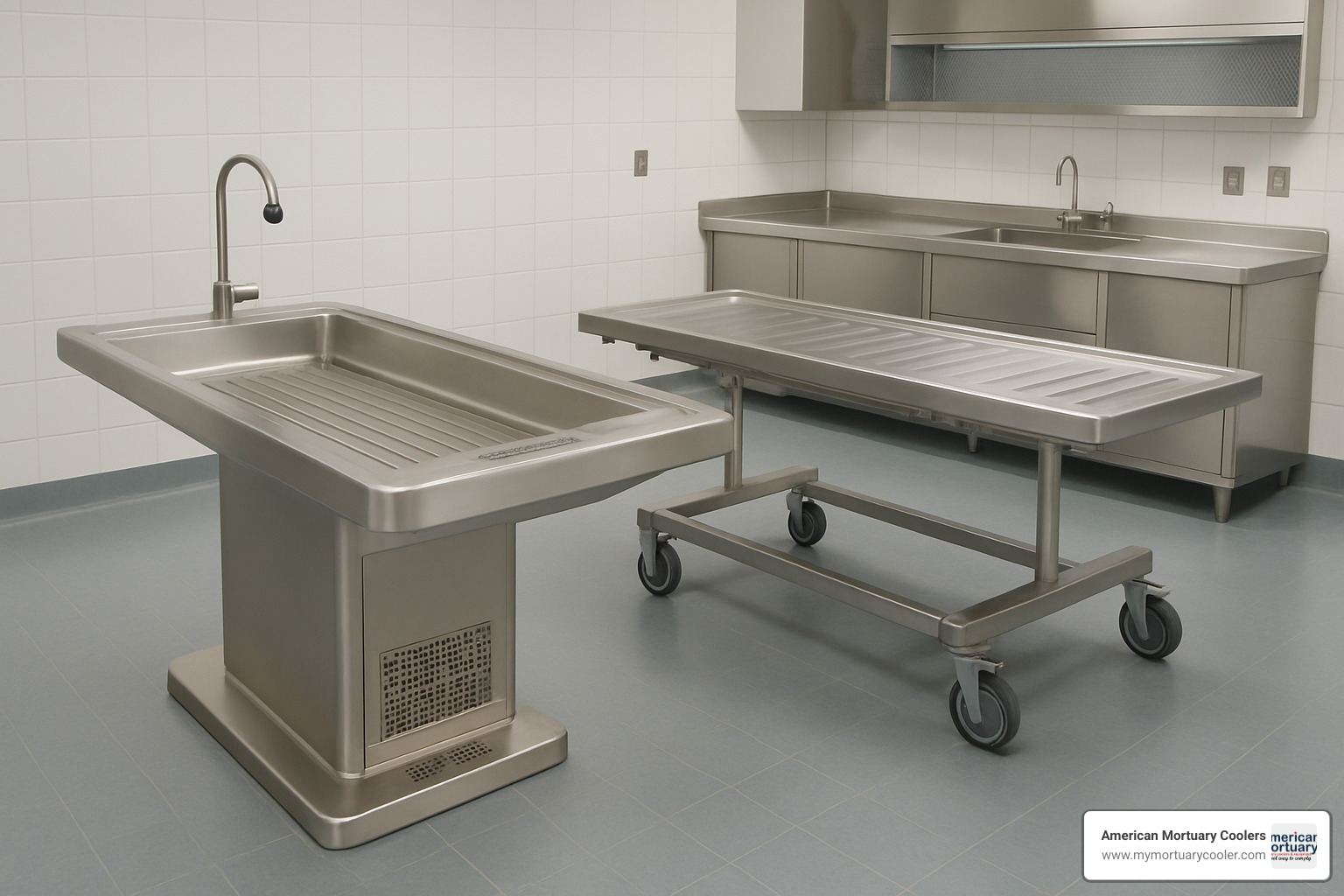
Stationary vs. Mobile Platforms
Fixed pedestal autopsy-table- designs provide optimal stability and durability. These permanently positioned tables connect to facility utilities, ideal for dedicated autopsy suites. Mobile platforms require heavy-duty casters handling combined table and body weight while maintaining smooth movement and secure locking during procedures.
Ventilated & Specialty Configurations
Ventilated systems require specific CFM ratings for effective airborne contaminant capture and removal. Negative pressure zones provide protection without creating uncomfortable working conditions. Bariatric configurations feature reinforced construction for larger cases, while L-shaped tables provide extended work surfaces and dual-operator access. Veterinary autopsy tables offer specialized dimensions and drainage optimized for animal necropsies.
Specifications, Accessories & Customization for Workflow Excellence
Standard autopsy-table- dimensions are approximately 99.75 inches long by 30.25 inches wide by 35.5 inches high. The 6-inch lift range significantly improves examiner comfort, while load capacities exceeding 500 kg handle routine to bariatric cases. Power requirements vary from standard electrical for basic tables to 220V, 50Hz for ventilated models. Quality tables meet OSHA and CDC standards for regulatory compliance.
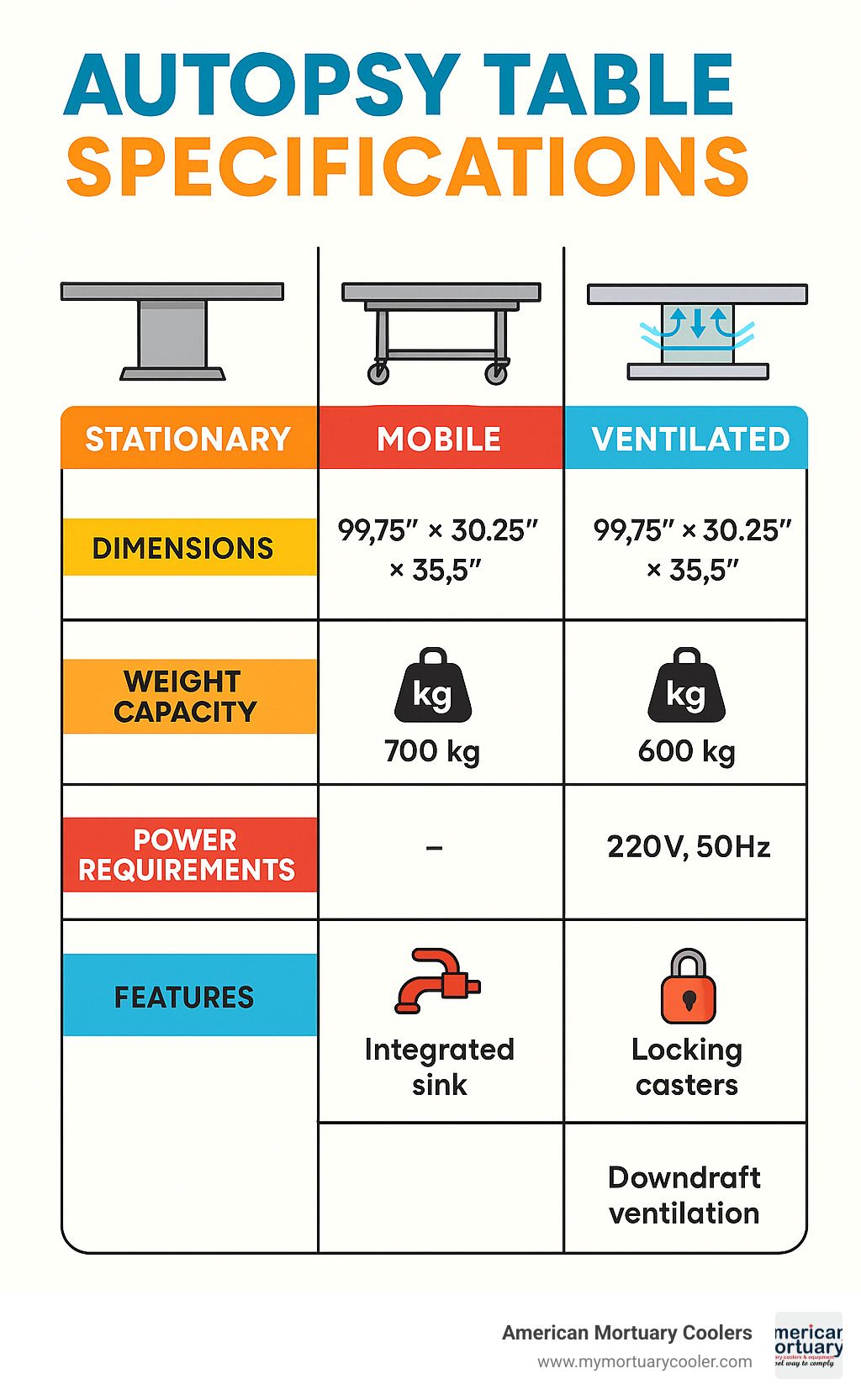
Built-In Accessories
Integrated sink systems with standard 14 × 20 × 10 inch dimensions provide essential fluid management. Mixing faucets with gooseneck spouts and 3-meter spray hoses offer cleaning flexibility. Hydro-aspirators with cold water valves and commercial-grade disposals handle waste materials safely.
GFCI outlets and power strips provide safe electrical connections for scales, cameras, and lighting. Dissection boards and scale mounts transform basic tables into comprehensive examination stations. Learn more about complementary equipment in our embalming table options guide.
Height Adjustment & Add-Ons
Electric hydraulic systems with push-button operation provide smooth height adjustment without interrupting workflow. Memory presets allow quick return to preferred working heights. Trendelenburg tilt functions enable precise table angling for improved drainage or examination access.
Rapid-transfer rollers minimize manual handling between storage and examination areas. Overhead sprayers, integrated cameras, and RFID tagging systems support modern documentation and chain-of-custody requirements.
Maintenance, Hygiene & Compliance Best Practices
Proper autopsy-table- maintenance ensures safety, professionalism, and equipment longevity. Modern stainless steel construction makes maintenance straightforward with correct procedures. Daily wash-down procedures form the backbone of care, using enzymatic cleaners specifically formulated for biological contamination that break down organic proteins without damaging stainless steel.
Regular stainless steel inspection during daily cleaning helps catch issues before expensive repairs. Even 316 grade steel requires attention to small scratches or chemical residues.
Cleaning & Disinfection
Low-foaming detergents prevent drainage system interference while providing effective cleaning. Most disinfectants need 10-minute contact time for pathogen elimination - plan cleaning routines accordingly. Sump flush procedures prevent debris buildup that creates odors or blockages.
Infection Control & Service
Ventilated autopsy-table- systems require regular CFM testing to ensure proper airflow rates. HEPA filter logs provide early warning for ventilation problems, while plume extraction checks verify aerosol capture under real conditions.
Lift cylinder lubrication keeps height adjustment systems operating smoothly. Gasket replacement schedules prevent air leaks that reduce ventilation effectiveness. Annual certification by qualified technicians provides peace of mind and satisfies regulatory requirements.

Innovations & Trends Changing Autopsy Tables
Autopsy-table- technology is evolving with smart sensors and IoT monitoring becoming real features that help facilities run smoother. These systems track usage patterns, maintenance needs, and environmental conditions, providing valuable data for facility planning.
Touchless faucets reduce cross-contamination by eliminating contact points during biological material handling. Water-saving valves and energy-efficient systems demonstrate environmental responsibility while reducing utility costs.
Digital Integration & Sustainability
4K cameras and advanced imaging systems are becoming essential documentation tools. Image capture rails and mounting systems ensure consistent, professional-quality documentation for forensic cases and educational sessions. Data ports and network connectivity enable real-time collaboration and expert consultation.
Modern manufacturers accept recycled steel content without compromising durability. Low-flow rinsers use significantly less water while maintaining thorough cleaning power. Energy-efficient fans and motors in ventilation systems maintain safety standards while using considerably less electricity.
Frequently Asked Questions about Autopsy-Table-
What material grade is best for autopsy-table- use?
316 grade stainless steel surpasses 304 grade for autopsy applications. The molybdenum content in 316 grade provides superior corrosion resistance against harsh disinfectants, biological fluids, and intensive cleaning protocols. This extra protection maintains professional appearance and structural integrity longer, especially in high-volume facilities.
How does downdraft ventilation protect examiners?
Downdraft ventilation creates negative pressure zones that capture contaminants at the table surface before they reach examiners. Peripheral extraction design grabs aerosols, odors, and dangerous particles immediately. Advanced systems combine HEPA filtration for biological hazards with activated carbon filters for odor control.
Can one table serve both human and veterinary autopsies?
Yes, standard autopsy-table- designs can handle both applications. However, specialized veterinary necropsy tables often provide better functionality with dimensions optimized for various animal sizes, specialized restraint systems, and modified drainage configurations. The decision depends on your facility's case mix and volume requirements.
Conclusion
Selecting the right autopsy-table- is crucial for medical facilities. These sophisticated systems represent the foundation of safe, efficient post-mortem examinations serving families, communities, and medical knowledge advancement.
The evolution from basic stainless steel tables to advanced systems with integrated ventilation, digital capabilities, and ergonomic features reflects growing understanding of examiner needs. Future-ready equipment incorporates smart sensors, sustainable materials, and modular designs adapting to changing technology.
Through years serving facilities across Tennessee, Atlanta, Chicago, Columbia, Dallas, Los Angeles, New York, Pittsburgh, and throughout all major regions, we've learned there's no one-size-fits-all solution. Busy urban medical examiner offices have different needs than small-town funeral homes or veterinary clinics.
The key is matching specific workflow requirements with proven performance features. Workflow efficiency and examiner safety should drive every equipment decision. The best autopsy-table- makes difficult work easier, dangerous procedures safer, and long days less taxing on staff.
At American Mortuary Coolers, we've built our reputation on understanding real-world needs. Our craftsmanship approach means partnering with facilities to find solutions that work for unique situations. Whether upgrading aging equipment or outfitting new facilities, we help steer options and find the right fit.
Quality autopsy equipment investment pays for itself through improved safety, better examination capabilities, and decades-lasting equipment with proper care. When you choose wisely, you're investing in your facility's ability to serve your community with professionalism and dignity.
For more information about mortuary solutions and to explore how the right equipment can transform your facility's capabilities, connect with our specialists who understand the unique challenges of post-mortem examination facilities.

















